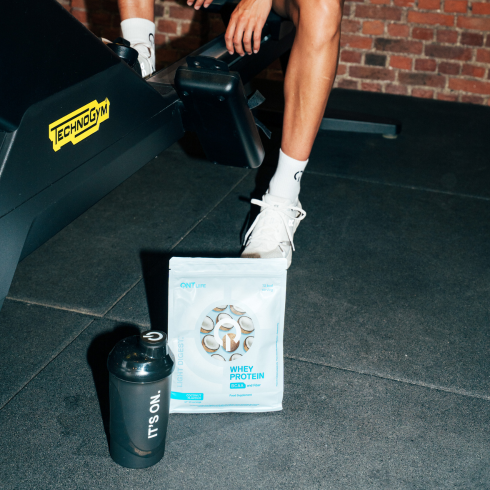Complete Guide to Protein Drinks
TABLE OF CONTENTS
- What is a protein drink?
- Why consume protein drinks?
- The different types of protein drinks
- Where do proteins come from?
- When should you consume a protein drink?
- How to choose your protein drink?
- The advantages and limitations of protein drinks
- Tips for optimal use
- Should you drink protein drinks every day?
- Should protein drinks be part of your daily routine?
- Common misconceptions
- Coach’s advice
WHAT IS A PROTEIN DRINK?
A protein drink is a liquid product formulated to contain a significant dose of protein. It can be animal-based (most often made from whey or casein) or plant-based (such as pea, rice, or soy), depending on dietary preferences or individual intolerances. These drinks are especially popular among athletes, active people, seniors, or those who want to lose weight or supplement an insufficient nutritional intake.
Designed to be convenient, quick to consume and often tasty, they provide a protein boost without the need to cook or carry a full meal. Thanks to their liquid format, they can easily be integrated at any time of the day.
There are generally three main types of protein drinks: ready-to-drink (RTD) versions, milk-based formulas, and clear proteins that are lighter and fruitier. Each meets different needs and preferences.
WHY DRINK PROTEIN SHAKES?
Protein drinks are not just for bodybuilders. They meet a wide range of needs related to health, performance, weight management, and even aging. Rich in essential amino acids, they provide a convenient, quick, and targeted source of protein. Here are the main reasons why they can make a real difference in a daily routine.
SUPPORT FOR MUSCLE BUILDING
When you engage in physical activity, especially weight training, crossfit, or endurance sports, muscle fibers are subjected to micro-tears. Protein is then essential to repair and rebuild these fibers.
Protein drinks, particularly those based on whey isolate or hydrolyzed whey, are rapidly absorbed, making them an ideal solution right after training. They immediately supply the amino acids required for protein synthesis, allowing for:
- better muscle growth (hypertrophy),
- limiting catabolism (muscle loss),
- more effective training progress.
Example: a drink containing 25 g of whey isolate within 30 minutes post-workout is an excellent habit to promote muscle development.
PROMOTES RECOVERY
The recovery phase plays a crucial role in any training plan. Without it, performance stagnates and the risk of injury increases.
Protein drinks help reduce soreness, muscle fatigue, and support the immune system, which is heavily challenged during intense efforts. Formulas enriched with BCAA (leucine, isoleucine, valine) or L-glutamine are particularly effective to:
- enhance tissue repair,
- replenish amino acid stores,
- reduce markers of inflammation.
Clear protein or enriched post-workout drinks are excellent tools for regular athletes or those returning to activity.
WEIGHT CONTROL AND SATIETY
Protein is the most satiating macronutrient, meaning it provides a stronger feeling of fullness compared to carbs or fats.
In this context, protein drinks:
- help prevent snacking between meals,
- replace sugary snacks with a more qualitative option,
- allow better control of daily calorie intake.
They are particularly useful in a diet, a cutting phase, or simply to avoid cravings during the day.
Example: a protein drink with 90 kcal and 20 g of protein can satisfy afternoon hunger while supporting metabolism.
COMPLEMENTARY NUTRITIONAL SUPPORT
Many people don’t meet their daily protein requirements, either due to lack of time or dietary choices:
- older adults (sarcopenia),
- vegetarians or flexitarians,
- people following low-calorie diets,
- students or busy workers who skip meals.
Protein drinks offer an easy solution to supplement intake, without cooking and without having to eat foods one doesn’t usually consume.
They also help maintain muscle mass while aging, reduce muscle loss during restrictive diets, and complement an unbalanced diet.
Example: a senior who struggles to eat solid proteins can integrate a protein milkshake into breakfast or after light activity.
OTHER ADDITIONAL BENEFITS
Beyond their main uses, protein drinks can also:
- support a lactose-free diet (thanks to vegan or lactose-free isolate versions),
- help stabilize nutrition for people with appetite disorders,
- be used during recovery phases to rebuild tissues.
Their versatility, accessibility (in gyms, supermarkets, or online shops), and wide variety of flavors make them particularly suitable for either daily or occasional consumption, depending on your goals.
THE DIFFERENT TYPES OF PROTEIN DRINKS.
There are several types of protein drinks, each with advantages depending on goals, lifestyle, and personal preferences. Two main categories dominate the market: ready-to-drink (RTD) protein beverages and protein powders to mix. Each serves different needs.
READY-TO-DRINK PROTEIN BEVERAGES (RTD)
RTD drinks come pre-made in bottles or cartons and can be consumed anytime during the day. They are designed to deliver a quick and convenient protein boost without measuring or mixing.
Perfect for active people:
- Post-workout, for fast recovery
- As a quick snack on the go, between meetings or while commuting
- For those who want to avoid preparation and don’t have a shaker handy
Advantages:
- Time-saving: no preparation needed
- Portable: fits in a gym bag, backpack, or even the glove compartment
- Often pleasant taste: creamy texture, multiple flavors
- Pre-measured: typically 20–25 g of protein per bottle
Disadvantages:
- Higher cost: usually 2 to 3 times more expensive than a powder serving
- Less customizable: no control over dosage or ingredients
- Sometimes higher in sugar or additives
Examples:
- Bottled milky whey shakes (chocolate, vanilla, coffee...)
- Clear protein RTDs, known for their fruity flavors, best enjoyed chilled
- High-protein drinks designed for high-protein diets
PROTEIN POWDERS TO MIX
Protein powders are the most common and customizable option. Sold in tubs or pouches, they must be mixed with a liquid: water, milk, or plant-based alternatives (almond, oat, soy...).
Maximum flexibility:
Mixable powders let you choose your serving size, mixing liquid, timing, and can even be added to recipes like smoothies, pancakes, or protein bowls.
Advantages:
- Cost-effective: cheaper per serving
- Adaptable: easily adjust the quantity to your needs
- Wide range of protein types: whey, isolate, casein, vegan, multi-source
- Large choice of flavors and formulas (sugar-free, enriched, etc.)
Disadvantages:
- Requires preparation: shaker or blender needed
- Less convenient on the go: requires water/liquid at hand
- Risk of clumping if poorly mixed (depending on powder quality)
Examples:
- Whey isolate for a quick post-training shake
- Casein, slow-digesting, ideal as an evening drink
- Vegan protein for a plant-based, lactose-free option
QUICK COMPARISON.
| Format | Practicality | Cost per serving | Preparation time | Taste | Customization |
|---|---|---|---|---|---|
| RTD (ready to drink) | ⭐️⭐️⭐️⭐️⭐️ | 💰💰💰 | ✅ immediate | ⭐️⭐️⭐️⭐️⭐️ | ❌ low |
| Powder to mix | ⭐️⭐️⭐️ | 💰 | ⚠️ shaker required | ⭐️⭐️⭐️⭐️⭐️ | ✅ high |
HOW TO CHOOSE BETWEEN RTD AND POWDER?
The choice depends on your lifestyle and priorities:
• Always in a hurry? Go for a ready-to-drink option, perfect in the car, at the office, or at the gym.
• At home or prefer full control? Powder to mix will be your ally to customize your intake.
• On long trips? Alternate both: RTD for moments without kitchen access, powder when you have time to prepare.
GOOD TO KNOW: YOU DON’T HAVE TO CHOOSE.
Both formats can coexist intelligently in your routine:
– An RTD in your gym bag for unexpected situations,
– Powder at breakfast or in a homemade smoothie,
– Casein powder in the evening, and a clear RTD at noon.
The key is to meet your daily protein needs with products adapted to your taste and lifestyle.
WHERE DO PROTEINS COME FROM?
THE DIFFERENT SOURCES OF PROTEINS IN DRINKS
Not all protein drinks are the same, as they are based on different protein sources. These influence not only nutritional quality, but also digestibility, taste, absorption speed, and even the amino acid profile (notably BCAAs, essential for muscle recovery).
We can distinguish two main families: animal proteins and plant proteins. Each source has its own advantages, and the choice depends on personal goals, lifestyle, and sometimes dietary restrictions.
ANIMAL PROTEINS
Animal proteins are the most commonly used in protein drinks, especially in products aimed at muscle building or recovery. They are highly bioavailable (meaning well absorbed by the body) and contain all essential amino acids, making them “complete” proteins.
WHEY
This is the star of proteins. Derived from milk, whey is rapidly digested and very rich in BCAAs, particularly leucine, a key amino acid for muscle synthesis.
Advantages:
- Ultra-fast absorption (ideal post-workout)
- Effectively stimulates muscle growth
- Smooth texture and pleasant taste
Types:
- Concentrate: traces of lactose and fats
- Isolate: filtered, almost no lactose or fats
- Hydrolyzed: pre-digested, even faster absorption
Ideal for: regular athletes, muscle gain, fast recovery
CASEIN
Also derived from milk, casein has a slow digestion rate (up to 7 hours). It forms a gel in the stomach, gradually releasing its amino acids.
Advantages:
- Prolonged satiety effect
- Continuous protein supply, ideal during sleep
- Helps preserve muscle mass
Ideal for: evening snack, appetite control, cutting phases
EGG PROTEIN
Less common but high quality, egg protein (albumin) has a very complete amino acid profile and digests almost as well as whey.
Advantages:
- Naturally lactose-free
- Very good absorption
- Less allergenic than dairy proteins
Ideal for: lactose intolerant individuals, complementing other sources, seeking an effective alternative
PLANT PROTEINS
Plant proteins are gaining popularity, driven by ethical, environmental, or digestive reasons. They are suitable for vegetarians, vegans, or lactose-intolerant people. Their digestibility and amino acid profile vary depending on the source used.
PEA
Pea protein is one of the most popular among plant sources. It has an excellent amino acid profile and good digestibility, with no lactose or gluten.
Advantages:
- Rich in BCAAs
- Low allergen risk
- Neutral taste, pleasant texture
Ideal for: vegans, intolerant individuals, complementing other plant proteins
SOY
Soy is a complete protein, containing all 9 essential amino acids. It is often compared to whey in terms of nutritional profile.
Advantages:
- Very good BCAA profile
- Rich in iron, magnesium, and phytoestrogens
- Well suited for vegetarian sports products
Note: some people prefer to avoid soy for hormonal reasons.
Ideal for: alternative to whey, balanced vegetarian or vegan diet
RICE, HEMP, OATS (AND OTHER PLANT SOURCES)
Often used as complements, these plant sources rebalance the amino acid profile, as some are deficient in lysine or methionine.
Types:
- Rice protein: very digestible, light, hypoallergenic
- Hemp: rich in omega-3, fiber, micronutrients
- Oats: mild taste, slightly higher in carbohydrates
Advantages:
- Low allergen risk
- Suitable for sensitive stomachs
- Natural and minimally processed solutions
Ideal for: combining sources, sensitive individuals, or transitioning to a plant-based diet
WHICH PROTEIN TO CHOOSE?
The choice depends on several factors:
- Sport objective: muscle gain, cutting, recovery
- Food tolerances: lactose intolerance, soy allergy, etc.
- Lifestyle: veganism, flexitarianism, or omnivorous
- Taste and texture preferences
There is no universal "best" protein, but rather choices adapted to each profile. Some brands even offer synergistic blends (e.g., pea + rice) to optimize the effects while respecting specific diets.
WHEN TO CONSUME A PROTEIN DRINK?
Consuming a protein drink is not random: the time of day influences how your body uses proteins. Depending on your goals — muscle gain, recovery, weight loss, or simple maintenance — certain times are strategic to get the most benefits from your protein intake.
AFTER WORKOUT: TO BOOST RECOVERY
This is perhaps the most well-known time to have a protein drink, and for good reason: after a workout, muscles have been stressed, sometimes damaged, and need readily available nutrients to begin repairing.
Why?
- Muscle fibers are in a reconstruction phase
- Amino acid reserves are depleted
- The body is in a receptive state, called the anabolic window (30 to 60 minutes after exercise)
Which drink?
- A whey isolate or hydrolyzed whey, valued for its fast absorption
- A fruity clear protein, light and refreshing
- A drink containing BCAAs or glutamine
Ideal for: strength training, HIIT, crossfit, or endurance sports
AS A SNACK: TO SATISFY HUNGER SMARTLY
Between meals, especially late morning or afternoon, it’s common to feel hungry. Instead of reaching for a sugary bar or cookies, a protein drink offers a healthy and filling alternative.
Why?
- Proteins are digested slowly, helping maintain satiety
- They prevent blood sugar spikes linked to sugary snacks
- They help stabilize energy until the next meal
Which drink?
- A protein milk drink, indulgent and nourishing
- A vegan protein mixed with a plant-based drink
- A homemade shake with fruits, protein powder, and seeds (chia, flax…)
Ideal for: reducing cravings, maintaining body composition, avoiding snacking
AT BREAKFAST: TO START THE DAY RIGHT
Breakfast is often low in protein, especially when it consists only of cereals, bread, or pastries. A protein drink easily fixes this, especially if you’re in a hurry or not very hungry in the morning.
Why?
- Immediate protein intake after the overnight fast
- Better hunger control throughout the day
- Avoids mid-morning fatigue
Which drink?
- Casein or a classic whey with a banana
- Protein powder mixed into a smoothie or porridge
- An RTD with coffee or chocolate flavor to replace a sugary latte
Ideal for: students, busy workers, people with low morning appetite
IN THE EVENING: FOR LONG-LASTING SATIETY AND MUSCLE MAINTENANCE
Contrary to popular belief, consuming proteins in the evening can be very useful, especially if you had a light dinner or want to nourish your muscles overnight.
Why?
- At night, the body enters a cellular repair phase
- A slow-digesting protein source supports muscles until morning
- It also helps limit nighttime cravings
Which drink?
- Casein, with slow digestion
- A vegan protein drink rich in fiber
- A warm “protein hot chocolate” style shake
Ideal for: maintaining muscle mass, weight loss, athletes in recovery, seniors
CAN YOU HAVE IT AT OTHER TIMES?
Yes. There is no “forbidden time” to consume a protein drink. Some use it:
- Before training, to avoid exercising on an empty stomach
- On a rest day, to reach their daily protein target
- As a replacement for a light meal or snack when traveling or very busy
The key is to integrate it wisely into your day, taking into account your needs, overall diet, and goals.
HOW TO CHOOSE YOUR PROTEIN DRINK?
With the wide variety available, choosing a protein drink can seem complex. Between differences in composition, texture, taste, and format, it is essential to make an informed choice based on your goals, nutritional needs, and personal preferences. Here are the main criteria to consider to find the drink that suits you best.
BASED ON YOUR GOALS
First and foremost, you should ask yourself the following question: why do I need a protein drink? Depending on your answer, the selection criteria will not be the same.
For muscle gain
- High in protein (minimum 20–25 g per serving)
- Moderate to high carbohydrate intake to support energy
- Possibly enriched with creatine or BCAAs
Example: a creamy milk-based drink with 30 g of protein and 20 g of carbs
For weight loss or cutting
- Low in sugars (less than 3 g per serving)
- Low in fat
- Rich in satiating proteins (casein, isolate...)
Example: a clear protein with 90 kcal and 20 g of protein, no added sugars
For sports recovery
- Fast-absorbing proteins (whey isolate, hydrolyzed)
- Contains BCAAs, glutamine, or electrolytes
- Moderate carbohydrate content to replenish stores
Example: an RTD drink enriched with BCAAs and 25 g of protein
READ THE LABEL CAREFULLY
Looks aren’t everything! It’s important to check the nutritional information and ingredient list to ensure the product fits your needs.
Protein content
- A good benchmark: between 15 and 30 g of protein per serving
- Less than 10 g is usually insufficient for a significant effect
- Post-workout: aim for 20–30 g
- As a snack: 15–25 g is usually enough
Presence of sugars or sweeteners
- Limit products with more than 5 g of simple sugars per serving
- Prefer natural sweeteners (stevia, erythritol)
Additives and preservatives
- Some products contain thickeners, colorants, or artificial flavors
- Choose a short and clear ingredient list
Tip: if the ingredient list exceeds 10 lines, it’s worth questioning the quality
TASTE AND TEXTURE: DON’T NEGLECT PLEASURE
Beyond the numbers, a good protein drink is one you enjoy consuming regularly. If you dislike the taste or texture, you’re likely to quit quickly, even if the formula looks excellent on paper.
- Taste: chocolate, vanilla, berries, coffee… try several flavors
- Texture: creamy (milk-based) or light (clear protein)
- Watch out for digestive sensitivities linked to sweeteners or concentrated proteins
Advice: start by buying a single unit or sample before investing in a full pack
GOOD HABITS TO ADOPT
- Identify your main goal (muscle, cutting, recovery, snack...)
- Analyze the composition: protein content, sugars, additives
- Test different formats and flavors to find what suits you
- Don’t buy solely based on marketing: a pretty label doesn’t guarantee a good product
The choice of the right protein drink is based on a balance between nutritional quality, taste pleasure, and alignment with your specific needs.
THE ADVANTAGES AND LIMITS OF PROTEIN DRINKS.
Protein drinks are becoming increasingly popular, both among athletes and people seeking a healthier lifestyle. Practical, effective, but not perfect, they deserve an objective evaluation of their strengths and weaknesses before being integrated into a routine. Here’s an overview of the main advantages and limits of these products.
THE ADVANTAGES OF PROTEIN DRINKS
Practical and quick
- No need to cook
- Easy to carry in a bag
- Ready to drink (RTD) or easy to prepare (powders)
- Ideal for busy people, on the go, or between appointments
Example: an RTD drink can be consumed right after a workout or between two business meetings
Easy control of nutritional intake
- Precise amount of protein per serving
- Possibility to choose formulas low in sugars, fats, or enriched depending on your goals
- Ideal for following a meal plan or specific diet
This makes it easier to track an objective, whether it’s weight loss, muscle development, or general maintenance
Low calorie depending on the version
- Less than 100 kcal for 20 g of protein (notably in clear proteins)
- Sugar-free and fat-free
- Helps increase protein intake without adding excess calories
Perfect for people in a calorie deficit, during a cutting phase, or monitoring their weight
Adaptable to different goals
- Recovery after endurance training
- Snack replacement for weight management
- Supplement for seniors, vegetarians, or active individuals
Their versatility makes them an effective nutritional tool in many contexts
THE LIMITS OF PROTEIN DRINKS
Do not replace a varied diet
- Low in fiber, healthy fats, and micronutrients
- Should not permanently replace fresh foods (meats, fish, legumes, eggs…)
- To be considered as an occasional supplement, not as a long-term dietary base
May contain additives
- Artificial sweeteners (sucralose, acesulfame-K)
- Flavors, colorants, thickeners, preservatives
Even if authorized, some consumers prefer more natural products, with a short ingredient list
Tip: always read the label and choose quality products without excessive additives
Risk of protein overconsumption
- Excess is transformed into waste and eliminated by the kidneys
- May cause unnecessary kidney strain without increased needs
- Dietary imbalance if protein intake is too high at the expense of other essential nutrients
Best practice: calculate your daily needs (generally between 1.2 and 2 g/kg of body weight) and adjust consumption accordingly
IN SUMMARY
| Advantages | Limits |
|---|---|
| Ready to use and easy to consume | Do not replace a complete diet |
| Help reach a precise protein target | Possible presence of additives or sweeteners |
| Low calorie depending on the version | Risk of overconsumption if misused |
| Versatile and suitable for various goals |
Protein drinks are powerful nutritional tools, provided they are used wisely, as a complement to a balanced diet and in line with personal goals. When chosen carefully, they can be a real asset in your wellness or sports routine.
TIPS FOR OPTIMAL USE.
Protein drinks can be valuable allies for health, fitness, and performance, provided they are used thoughtfully. As with any dietary supplement, their effectiveness depends primarily on consistency, moderation, and integration into an overall healthy lifestyle. Here are some essential tips to get the most out of your protein drinks while respecting your body’s needs.
DON’T OVERDO IT
Proteins are essential nutrients, but they are not magical. Unlike fats and carbohydrates, proteins are not stored but broken down into compounds like urea, then eliminated through the kidneys.
Why it matters:
- Daily overconsumption can unnecessarily overload the renal system.
- It brings no additional benefits once needs are met.
- The body does not turn excess protein into muscle, but into energy… or fat.
What to do:
- Calculate your needs: generally between 1.2 g and 2 g of protein per kg of body weight per day, depending on physical activity.
- Take into account proteins provided by regular food: meat, fish, eggs, legumes…
- Protein drinks should complement your diet, not overload it.
Example: A 70 kg person practicing regular physical activity will need between 105 and 130 g of protein per day!
STAY WELL HYDRATED
A high protein intake generates an increased production of metabolic waste (notably urea), which the kidneys must filter and eliminate. Proper hydration is essential to support this process.
Why it’s crucial:
- Helps flush out waste from amino acid metabolism.
- Prevents kidney fatigue.
- Supports good digestion and prevents constipation (often linked to high-protein, low-fiber diets).
Practical tips:
- Drink 1.5 to 2 liters of water daily, minimum — even more if you consume a lot of protein or train regularly.
- Avoid drinking only during meals or workouts: spread hydration throughout the day.
- Include herbal teas, lemon water, or broths to keep it varied.
Tip: your urine should be clear to light yellow. If it’s dark, you’re not drinking enough.
COMBINE WITH A BALANCED DIET
Protein drinks should not be considered equivalent to a well-composed plate of food. They are useful but should not become a permanent substitute for fresh, varied, whole foods. To stay healthy, the body needs an overall balance of macronutrients and micronutrients.
Why this complementarity is essential:
- Proteins alone are not enough to nourish muscles, the brain, or the immune system.
- You also need complex carbohydrates (energy), quality fats (hormones, brain), fiber (digestion, satiety), vitamins and minerals (immunity, cellular energy).
Best practices:
- Always combine your protein shakes with a rich and varied diet:
• Colorful vegetables (fiber + antioxidants)
• Fresh fruits (vitamins + hydration)
• Whole grains (steady energy)
• Healthy fats (avocado, olive oil, seeds, nuts)
- Diversify your protein sources by combining animal and plant-based proteins.
Protein drinks are a useful complement, but they do not replace a balanced diet. They should support a healthy lifestyle, not replace it.
TO FULLY ENJOY THE BENEFITS OF PROTEIN DRINKS
- Use them in moderation and according to your real needs.
- Stay properly hydrated to support absorption and elimination.
- Make sure to combine them with a complete, balanced diet.
When used correctly, they can be powerful levers for your fitness, energy, and performance — provided you stay in control of your consumption and not the other way around.
SHOULD YOU DRINK A PROTEIN SHAKE EVERY DAY?
This is a common question for both beginners and experienced athletes. Should you systematically include a protein drink in your daily routine? The answer is nuanced: it all depends on your overall diet, your personal goals, and your level of physical activity. There is no universal rule, but rather a smart adjustment based on individual needs.
IF YOUR DIET IS ALREADY RICH IN PROTEIN
If you regularly consume:
- Lean meats (chicken, turkey…)
- Fish (tuna, salmon, sardines…)
- Eggs, dairy products, legumes (lentils, chickpeas)
- And if your meals are balanced and varied
… then you are probably already meeting your daily protein requirements. In this case, systematically adding a protein drink is not necessary, or even useless, except occasionally (after an intense workout, during travel, or if you skip a meal).
Example: an active adult weighing 70 kg needs around 105 to 130 g of protein per day. A well-structured regular diet can easily provide this amount.
WHEN TRAINING REGULARLY
When training 3 times a week or more, protein needs increase:
- To repair stressed muscle fibers
- To support performance
- To encourage adaptation to effort
In this context, including a protein drink every day can be useful, especially if:
- You can’t always eat within an hour after training
- You struggle to meet your protein intake through food alone
- You are in a progression phase (muscle gain, volume, strength…)
Tip: choose a whey or clear protein after training to optimize recovery.
IF YOU ARE VEGETARIAN OR FLEXITARIAN
People who eat little or no animal products often need to make more effort to cover their protein needs:
- Plant sources are sometimes incomplete or less bioavailable
- Combining several sources is necessary (e.g., rice + pea)
- It is harder to reach 1.5 g of protein/kg of body weight without planning
In this case, a daily protein drink:
- Simplifies intake
- Helps avoid deficiencies
- Provides a well-dosed, digestible, and easy-to-integrate option
Ideal: multi-source plant proteins (pea, rice, hemp), enriched with BCAAs.
FOR SPECIFIC GOALS: MUSCLE GAIN OR WEIGHT LOSS
For muscle gain:
You need more calories and protein than usual. A daily protein drink rich in protein (and possibly carbs) can help you reach your target without overloading digestion.
For weight loss:
It’s essential to preserve muscle mass while reducing calories. A protein drink low in sugar but high in protein is an excellent snack or light meal replacement.
In both cases, daily intake is not only useful but recommended.
ALTERNATIVE: FLEXIBLE CONSUMPTION
You don’t need to consume a protein drink every day systematically. Adopting some flexibility can be more effective:
- Yes after workouts
- Yes if a meal is skipped or unbalanced
- Yes as a snack when hunger strikes
- No if your meals already meet your needs
Best practice: listen to your body, adapt according to the day, and use protein drinks as strategic tools, not as an obligation.
IN SUMMARY
A daily protein drink is not essential for everyone, but it can be beneficial in many cases: regular athlete, plant-based diet, body transformation goal, or very active lifestyle.
The key is to know your real needs, evaluate your diet, and make this supplement a thoughtful ally — not an automatic routine.
THE BEST PROTEIN DRINKS FOR YOUR NEEDS.
| Goal | Recommended type | Best time |
|---|---|---|
| Muscle gain | Whey isolate or concentrate | Right after training |
| Weight loss | Plant protein, low in sugar | As a snack |
| Recovery | Whey enriched with BCAAs | Immediately after exercise |
| Vegan | Pea/rice/hemp blend | Anytime |
| Senior | Casein, soy | As a snack or in the evening |
SHOULD YOU INCLUDE PROTEIN DRINKS IN YOUR DAILY ROUTINE?
Protein drinks are not miracle solutions, nor are they essential. They represent a strategic nutritional tool, to be integrated intelligently and personally, depending on your lifestyle, eating habits, and goals.
Practical for everyday use, but not enough to replace a real meal.
Easy to carry, quick to consume, available in dairy, clear, or plant-based versions, protein drinks adapt to all profiles:
• Athletes looking to optimize recovery and muscle gain,
• Active people needing a healthy and filling snack,
• Seniors or vegetarians wanting to supplement their nutrition.
They provide a targeted protein intake, with precise dosing, ideal for those who struggle to meet their daily needs through traditional food alone.
THE IMPORTANCE OF PROPER DOSING AND BALANCE
To be beneficial, protein drinks must be used in moderation:
• Respect your daily requirements.
• Avoid making them a systematic reflex.
• Integrate them into a varied diet, rich in vegetables, healthy fats, complex carbs, and micronutrients.
Excessive consumption, disconnected from real needs, will not bring more results and may ultimately harm the overall balance of your diet.
A VALUABLE AID TO ACHIEVE YOUR GOALS
Whether it’s about:
• Building muscle,
• Losing fat without losing muscle mass,
• Improving your recovery,
• Or simply improving your daily physical well-being.
… When used wisely and adapted to your needs, protein drinks can bring real added value.
IN SUMMARY
Yes, if you struggle to reach your protein target.
Yes, if you train regularly.
Yes, if you want a healthy, practical, and balanced snack.
No, if your diet is already rich and complete in protein.
No, if you use them excessively at the expense of real dietary variety.
Including a protein drink in your daily routine should never be a constraint, but rather a chosen strategy — serving your health, performance, and overall well-being.
COMMON MISCONCEPTIONS ABOUT PROTEIN DRINKS.
Protein drinks are often surrounded by misconceptions, fueled by clichés or incomplete information. Yet, they are neither reserved for bodybuilders, nor synonymous with chemicals or health risks. Here are the main misconceptions to deconstruct in order to better understand their real usefulness.
“Protein drinks are only for bodybuilders”
One of the most widespread myths is that only intensive weightlifters or professional athletes can or should consume protein drinks.
In reality, they are aimed at a much broader audience: active individuals, amateur athletes, seniors who want to preserve their muscle mass, vegetarians, or those who simply want to improve their nutritional balance.
“They are bad for the kidneys”
Many fear that regular protein consumption harms kidney function.
This idea comes from confusion between the recommendations for people with chronic kidney disease and those for the general population. For healthy individuals, an appropriate protein intake, even daily, poses no risk to the kidneys. Only those with an existing renal condition require specific monitoring.
“A protein drink replaces a meal”
Another frequent misconception is thinking that a protein shake can serve as a full meal.
Except in the case of products specifically designed as meal replacements (and enriched with carbs, fiber, fats, vitamins, etc.), protein drinks are supplements. They should be integrated into a balanced diet, not permanently replace real food.
“They contain too much sugar or additives”
Some people still associate these products with highly processed formulas, loaded with sugar and artificial sweeteners.
That may have been the case years ago, but today’s options are much more diverse and higher quality. There are now protein drinks without added sugars, lactose-free, free of artificial flavors, and even made from certified organic plant sources. It all depends on the product you choose.
“The more I drink, the more muscle I build”
The belief that increasing protein intake beyond actual needs will boost muscle results is false.
The body has a limited capacity to absorb protein at any given time. Excess protein is not used to build muscle but is converted into waste or stored as fat. What matters is not the sheer amount, but the right dosage at the right time, aligned with training.
“All protein sources are the same”
It is also common to think that all proteins provide the same benefits.
In reality, each type of protein has its own characteristics:
• Whey is quickly absorbed;
• Casein digests slowly;
• Plant proteins vary in amino acid profiles and sometimes need to be combined to be complete.
The choice depends on goals, digestive tolerance, and dietary preferences.
“Protein shakes make you lose weight”
Some still mistakenly associate protein drinks with weight-loss diets.
It is not the protein itself that causes weight loss, but the overall calorie deficit. However, a protein drink can support weight loss by increasing satiety, reducing cravings, and helping preserve muscle mass during a diet, provided it is included as part of a balanced nutritional approach.
COACH'S TIPS

- The convenience of protein drinks is truly something very important when you want to follow a competition diet while keeping a job or other commitments! It allows you to maintain a protein intake even when you don’t have time to eat.
- Taking a liquid protein after exercise ensures a fast and directly absorbable protein intake, but never think you can replace a balanced diet with it.
Related posts
-
 Summer holidays: How to limit the damage?
Posted in: Our tips24/06/2021On holiday, we often tend to let ourselves go. Unless you're a hardcore sportsman, you tend to abandon your trainers...Read more
Summer holidays: How to limit the damage?
Posted in: Our tips24/06/2021On holiday, we often tend to let ourselves go. Unless you're a hardcore sportsman, you tend to abandon your trainers...Read more -
 Which fat burner to choose?
Posted in: Our tips26/05/2021To lose weight and burn fat, there is no secret: you have to do sport and take care of your diet. However, it is...Read more
Which fat burner to choose?
Posted in: Our tips26/05/2021To lose weight and burn fat, there is no secret: you have to do sport and take care of your diet. However, it is...Read more -
 Summer body edition for men: How to prepare your body?
Posted in: Our tips11/05/2021Gentlemen ? The return of the sun and its warm rays are almost here! The degrees are slowly but surely rising, but...Read more
Summer body edition for men: How to prepare your body?
Posted in: Our tips11/05/2021Gentlemen ? The return of the sun and its warm rays are almost here! The degrees are slowly but surely rising, but...Read more -
 9 good reasons to do sport.
Posted in: Our tips22/04/2021Sometimes the urge to exercise is not always there. And although we always tell ourselves that this year will finally...Read more
9 good reasons to do sport.
Posted in: Our tips22/04/2021Sometimes the urge to exercise is not always there. And although we always tell ourselves that this year will finally...Read more -
 Discover how to take care of your faithful companion: your shaker!
Posted in: Our tips07/04/2021In your bag, in your hand, in your sink, it is everywhere! The shaker is an essential element of any good training....Read more
Discover how to take care of your faithful companion: your shaker!
Posted in: Our tips07/04/2021In your bag, in your hand, in your sink, it is everywhere! The shaker is an essential element of any good training....Read more
Blog categories
Popular posts
-
 10 Expert Tips to Maximize the Effectiveness of Creatine26/08/2024Posted in: Our tipsThis article presents ten tips to maximize the effectiveness of creatine. It emphasizes the importance of choosing...Read more
10 Expert Tips to Maximize the Effectiveness of Creatine26/08/2024Posted in: Our tipsThis article presents ten tips to maximize the effectiveness of creatine. It emphasizes the importance of choosing...Read more -
 Looking thinner but at a heavier weight? Is that possible?04/10/2021Posted in: Our tipsAdvertising has shaped our thinking! We have been forced for years to believe that losing weight is the key to having...Read more
Looking thinner but at a heavier weight? Is that possible?04/10/2021Posted in: Our tipsAdvertising has shaped our thinking! We have been forced for years to believe that losing weight is the key to having...Read more -
 10 BENEFITS OF GLUTAMINE.02/01/2024Posted in: Our tipsDiscover the power of L-glutamine, an underrated superhero in the world of amino acids! Essential for revitalizing...Read more
10 BENEFITS OF GLUTAMINE.02/01/2024Posted in: Our tipsDiscover the power of L-glutamine, an underrated superhero in the world of amino acids! Essential for revitalizing...Read more -
 L-carnitine and weight loss.15/10/2024Posted in: Our tipsDiscover how carnitine works on weight loss, even without exercise. This article reveals whether this supplement can...Read more
L-carnitine and weight loss.15/10/2024Posted in: Our tipsDiscover how carnitine works on weight loss, even without exercise. This article reveals whether this supplement can...Read more -
 Proteins for weight loss !29/12/2023Posted in: Our tipsDive into the fascinating world of proteins and their key role in weight loss. Discover how to choose the best...Read more
Proteins for weight loss !29/12/2023Posted in: Our tipsDive into the fascinating world of proteins and their key role in weight loss. Discover how to choose the best...Read more

.jpg)

